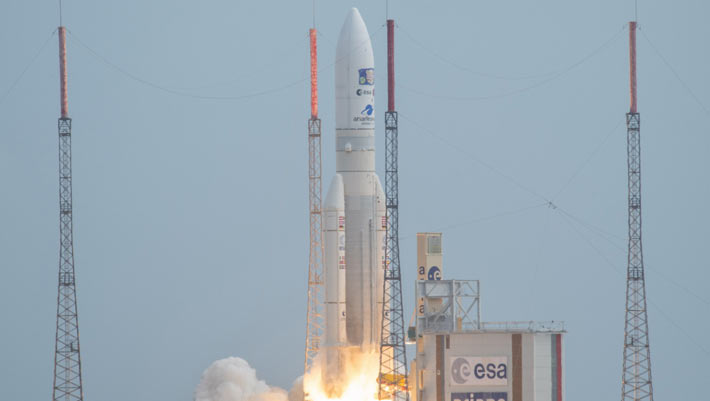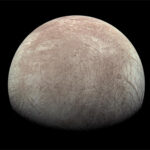ESA’s latest interplanetary mission, the JUpiter ICy Moons Explorer (JUICE), lifted off on an Ariane 5 rocket from Europe’s Spaceport in French Guiana, at 14:14 CEST on April 14, 2023, to begin its eight-year journey to the Jovian system. JUICE will make detailed observations of the gas giant and its three large ocean-bearing moons: Ganymede, Callisto and Europa. This ambitious mission will characterize these moons with a powerful suite of remote sensing, geophysical and in situ instruments to discover more about these compelling destinations as potential habitats for past or present life. JUICE will monitor Jupiter’s complex magnetic, radiation and plasma environment in depth and its interplay with the moons, studying the Jovian system as an archetype for gas giant systems across the Universe.
Thanks to the legacy of previous Jupiter missions, planetary reseachers know that three of the gas giant’s largest moons — Europa, Ganymede and Callisto — hold quantities of water buried under their surfaces in volumes far greater than in Earth’s oceans.
These planet-sized moons offer us tantalising hints that conditions for life could exist other than here on our ‘pale blue dot,’ and JUICE is equipped to bring us one step closer to answering this alluring question.
Over the next two-and-half weeks, JUICE will deploy its various antennas and instrument booms, including the 16-m-long radar antenna, 10.6-m-long magnetometer boom, and various other instruments.
An eight-year cruise with four gravity-assist flybys at Earth and Venus will slingshot the spacecraft towards the outer Solar System.
The first flyby in April 2024 will mark a space exploration first: JUICE will perform a lunar-Earth gravity-assist — a flyby of the Moon followed 1.5 days later by one of Earth.
JUICE lifted off on an Ariane 5 rocket from Europe’s Spaceport in French Guiana on April 14, 2023. Image credit: M. Pédoussaut / ESA.
“ESA, with its international partners, is on its way to Jupiter,” said ESA Director General Josef Aschbacher.
“JUICE’s spectacular launch carries with it the vision and ambition of those who conceived the mission decades ago, the skill and passion of everyone who has built this incredible machine, the drive of our flight operations team, and the curiosity of the global science community.”
“Together, we will keep pushing the boundaries of science and exploration in order to answer humankind’s biggest questions.”
“It is thanks to the leadership of ESA and the effort and commitment of hundreds of European industries and scientific institutions that the JUICE mission has become a reality,” said Giuseppe Sarri, ESA’ s JUICE project manager.
“Together with our partners NASA, the Japan Aerospace Exploration Agency and the Israel Space Agency, who have also contributed hardware or scientific instrumentation, we have reached this much-awaited launch milestone.”
“Over 400 years ago, Galileo discovered moons orbiting Jupiter — news that shocked the Renaissance world and revolutionised humankind’s understanding of our place in the Universe,” said Carole Mundell, ESA’s Director of Science.
“Today, we have sent a suite of ground-breaking science instruments on a journey to those moons that will give us an exquisite close-up view that would have been unimaginable to previous generations.”
“JUICE carries the dreams of anyone who’s ever gazed up at Jupiter shining brightly in the night sky and wondered about our origins.”
“The treasure trove of data that JUICE will provide will enable the science community worldwide to dig in and uncover the mysteries of the Jovian system, explore the nature and habitability of oceans on other worlds and answer questions yet unasked by future generations of scientists.”
“What a magnificent demonstration of Europe’s capacity to dream big and deliver results to match,” said Daniel Neuenschwander, ESA’s Director of Space Transportation.
“We can all be proud of Ariane 5 for making possible missions like JUICE and setting such a high standard for our new generation of launch systems.”
“Hundreds of millions of km from Earth and powered by just a sliver of sunlight, we will guide JUICE through 35 flybys of Jupiter’s ocean moons in order to gather the data needed to bring scientists closer than ever to these compelling destinations,” said Ignacio Tanco, ESA’s JUICE spacecraft operations manager.
“To fly such a complex path from such an enormous distance — and vitally, to get JUICE’s valuable data home to Earth — will require precise navigation techniques, reliant on ESA’s deep space antennas in Spain, Argentina and Australia, all controlled remotely from ESOC.”
“We are ready to steer one of the most complex missions ESA has ever flown to adventures in the Jovian system,” said Angela Dietz, deputy spacecraft operations manager.
“From flybys of Jupiter’s moons over a period of two-and-a-half years, to the immense challenge of switching orbits from massive Jupiter to orbiting Ganymede, we’ll be solving challenges at mission control that have never been done before.”





